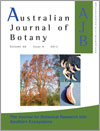Australian Journal of Botany
Volume 60
Number 6 2012
This study explored relationships between leaf traits that protect against critically high leaf temperatures in Australian arid zone plants. Results indicate trait replacement between certain traits and co-variation between others, particularly leaf mass per area, placing many of these thermal protective traits along the leaf economics spectrum.
Phylogenetic studies suggest that Erythrina dominguezii belongs to a basal clade characterised as pollinated by both passerines and hummingbirds. Our results show that E. dominguezii has a generalised pollination system involving hummingbirds, passerines and bees. This is the first study that compares effectiveness among different pollinators in Erythrina.
Landsat satellite imagery in combination with orthophotos and trend analysis were successfully employed to identify the presence of vegetation impacted by the plant pathogen Phytophthora cinnamomi, and to assess the historical extent and rate of spread (1953-2008) of the pathogen in Banksia woodlands in Western Australia. These techniques provide a cost-effective tool for management of this plant pathogen.
Miconia albicans and M. stenostachya are male sterile plants. The study of pollen development showed that meiosis is rare in M. albicans and irregular in M. stenostachya, leading to the pollen abortion. Abnormalities did not reach the production of Übisch bodies, suggesting little or no tapetum involvement in male sterility in these two species.
Senecio coincyi (Asteraceae) is a threatened endemic plant of central western Spain. The reproductive success and germination behaviour of this species were studied. S. coincyi showed high reproductive success and, therefore, its conservation problems are not due to agents related to its reproduction, but rather to other factors such as alteration of its habitat caused by the presence of livestock.
In this study the diversity and phylogenetic relationships of Ganoderma isolates from Cameroon were determined. Eight Ganoderma species were identified based on comparative morphology and DNA sequence comparisons. Of these, Ganoderma ryvardense Kinge and Mih is a new species, Ganoderma cupreum and Ganoderma weberianum are new records from this country and the remaining species are probably new to science.
Macfadyena unguis-cati (L.) Gentry (Bignoniaceae) is a major environmental weed in coastal Queensland, Australia. Soils from infested vs uninfested areas, and leaves of M. unguis-cati and three co-occurring vine species were collected at six sites and effects of invasion status, species, site and habitat type were examined using univariate and multivariate analyses.
Fire-sensitive Callitris glaucophylla saplings have regenerated densely in woodlands dominated by C. glaucophylla and fire-tolerant Eucalyptus species in semiarid SE Australia. We examined long-term competitive interactions between saplings and canopy trees. Canopy trees do not exclude but moderate sapling regeneration, which reduce the survival of canopy trees during drought.
A Calliandra brevipes apyrase was identified as a band of 75 kDa in the tissues of non-galled stem and leaves. In globose galls of this plant, the apyrase activity increases. By histochemical techniques, its ADPase activity was found homogeneously distributed at the external surface, and inside the nutritive cells.




